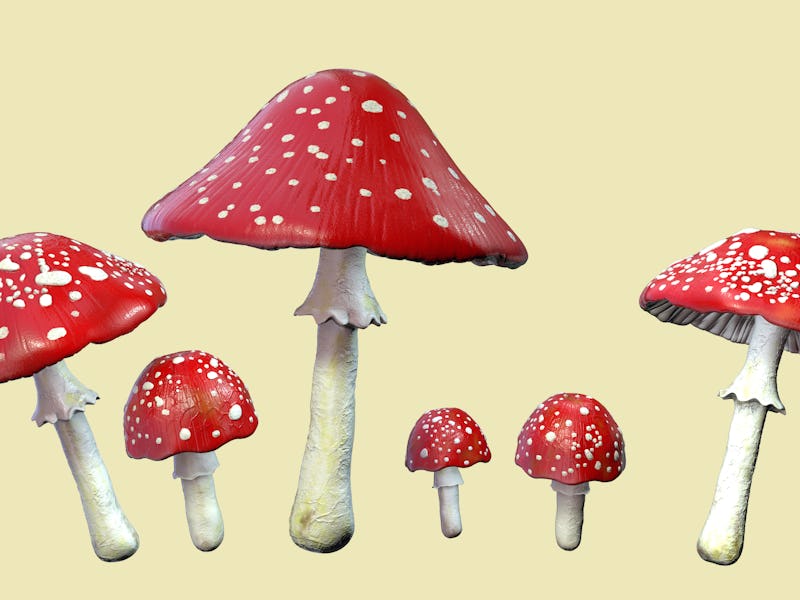LSD and Magic Mushrooms Dramatically Rewire the Brain, New Study Reveals
This finding could usher in a new type of antidepressant and expand psychedelic-assisted therapy.

From ketamine drips to microdosing on LSD, psychedelics are shaking up the way we approach and treat mental health. A growing body of scientific evidence shows that these long-stigmatized substances could be potential antidepressants, alleviating symptoms by slipping into areas of the brain traditional SSRIs can’t reach, and encouraging new neural connections.
Despite these advances, psychedelics remain fairly mysterious. Researchers haven’t yet pinned down the various mechanisms through which they work inside our bodies. But now, they might be one step closer.
An international team of scientists led by the University of Helsinki in Finland believes they’ve struck biochemical gold. In a study published Monday in the journal Nature Neuroscience, the researchers found that psychedelics psilocin (the primary chemical in magic mushrooms) and LSD exert an antidepressant effect by binding to a protein, receptor tyrosine kinase beta (TrkB), which then activates brain-derived neurotrophic factor (BDNF), a protein that plays a crucial role in the growth, development, and maintenance of neurons; kind of like Miracle-Gro for the brain.
“I think [this study] is very exciting,” Greg Fonzo, co-director of the Center for Psychedelic Research and Therapy at The University of Texas at Austin’s Dell Medical School, who wasn’t involved in the study, tells Inverse. “It establishes a potential common mechanism for psychedelics along with other kinds of antidepressant treatments.” The researchers hope that this new information could potentially lead to creating more effective treatments for mental health disorders.
Turning on neural plasticity
Despite their potential, psychedelics also come with a risk: the altered state of consciousness, the actual psychedelic trip with its hallucinations either enlightening or downright terrifying. It’s a risk that has limited widespread clinical use of psychedelics, barring individuals with pre-existing or a family history of psychiatric conditions, like schizophrenia and bipolar, from psychedelic-assisted therapy, David Olson, director of the Institute for Psychedelics and Neurotherapeutics at the University of California, Davis, tells Inverse.
That’s why there’s been a concerted effort to better understand the biochemical pathways psychedelics traverse once in our brains, what exactly these pathways do, and potentially engineer out the hallucinogenic ones while keeping the antidepressant ones.
In a previous study published in 2021, researchers at the University of Helsinki found that several antidepressants like Prozac, imipramine, and ketamine appear to interact with TrkB, alleviating depression, at least in mice, by boosting BDNF and encouraging neuronal plasticity, all without upping serotonin levels (the serotonin receptor is believed to be behind the hallucinogenic effects of psychedelics) or decreasing glutamate, a chemical that’s also been implicated in depression.
In the new study, the researchers gave neurons in a Petri dish either LSD or psilocin. In both instances, the psychedelics sought out TrkB and enthusiastically bound to it 1,000 times more strongly than Prozac or ketamine. They found this binding didn’t happen at the active site — think of it like a protein’s main keyhole — but at the portion of the protein embedded in the cell membrane, what’s called the transmembrane region.
This binding appeared to help TrkB interact with Miracle-Gro BDNF better than it ordinarily would have been able to, thereby increasing neuroplastic activity.
But how does this translate to actual living organisms? To do that, the researchers gave lab mice psilocin and LSD and watched to see if the animals tripped balls or not. Obviously, mice aren’t humans, so it’s a bit harder to tell when they enter whatever is their equivalent of an altered state of consciousness. Scientists usually use head twitching — a motion that’s been associated with activating serotonin receptors — as the best way to tell.
Compared to lab mice genetically engineered with mutated TrkB, the mice given LSD and psilocin did not exhibit the characteristic head twitch. This suggested, just as the 2021 study found, activating TrkB and BDNF with these psychedelics does not involve the hallucinogenic serotonin pathway.
A psychedelic-derived antidepressant?
Olson and Fonzo both say this research adds to the effort to uncover ways to make antidepressants more effective without triggering the undesirable, hallucinogenic side of psychedelics. Down the road, drugs engineered to target this TrkB/BDNF pathway could open up the accessibility of psychedelic-assisted therapy for many folks, especially as mental health issues and illnesses seem to continue to rise. Currently, while legislation approving such treatments varies across the US, psychedelic-assisted therapy requires specialized medical supervision in a clinical setting.
“If we try to engineer out the psychedelic aspect, that would make [such drugs] more accessible in a sense that there’s less concern [of safety],” says Fonzo.
However, it’s still not clear whether what scientists see with neurons in Petri dishes and mice will be the same effect in humans, especially considering the complexity of the human brain where nothing is really one-to-one. The next hurdles will be further studies followed by drug development and testing; clinical trials in humans may be many years away.